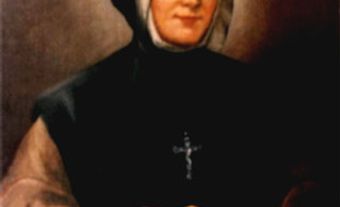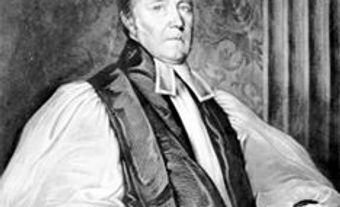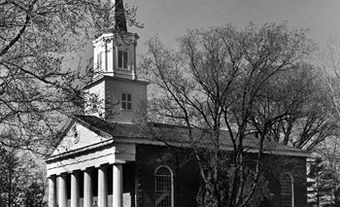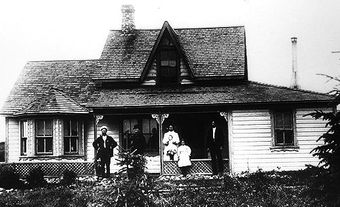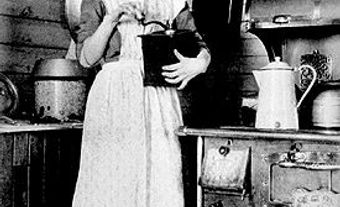Lutherans are adherents of the Christian church founded by 16th-century Protestant reformer Martin Luther. The central doctrine, justification by grace through faith alone for the sake of Jesus Christ, concentrates on God's favour to every person and not on each person's actions toward God. In the 2011 National Household Survey (NHS), 478,185 Canadians identified as Lutheran.

Overview
Lutherans believe that the understanding of God’s favour depends upon proclamation and interpretation of the Word. Preaching is the Lutheran church's hallmark. Lutheranism reduced the number of sacraments from seven to two: baptism and the Lord's Supper ( see Catholicism in Canada). An emphasis upon pure doctrine derived from Lutheran orthodoxy and the stress upon holy living of pietism are post-Reformation shifts imported to Canada principally from the US. The doctrinal stance of the Lutheran Church is determined by the acceptance of the Scriptures as sovereign over church tradition and as normative for faith and life, and by subscription to the Lutheran Confessions, composed between 1530-80.
Lutheran Jurisdictions in Canada
There are two Lutheran jurisdictions in Canada. They are the Evangelical Lutheran Church in Canada (ELCIC) and Lutheran Church – Canada (LC-C). The ELCIC, a merger of the Lutheran Church of America and the Evangelical Lutheran Church of Canada, effective 1 January 1986, is headquartered in Winnipeg, Manitoba. The LC-C consists of the districts of the Lutheran Church Missouri Synod in Canada, federated since 1958 and self-governing since January 1989. Matters of inter-Lutheran concern are handled through the Lutheran Council in Canada (federated 1967).
Lutheranism in Eastern Canada
Lutheran history in eastern Canada has been determined by US affiliations. Congregations were established 1752 in Halifax, Nova Scotia, and 1784 in Dundas County, Ontario. The mission suffered early on from lack of personnel and fiscal support from the parent US body; conflict with Anglicans; rivalry among the Lutheran denominations; and imposters posing as evangelical ministers. Confined principally to German settlements, churches associated with the New York Ministerium and the Pittsburgh Synod later found themselves competing with the Lutheran Church, Missouri Synod. In the mid-19th century the Pittsburgh Synod created a Canada Conference, and in 1876 the Nova Scotia Conference. These and an English Conference became units of the General Council, then of the successor United Lutheran Church in America in 1918. In 1962 they combined into a single synod upon formation of the LCA and in 1985 of the ELCIC. Meanwhile, in 1879 LCMS had formed its Canada District (renamed Ontario District in 1922), and the English District in 1911. Three US districts also functioned in Ontario. Movement toward an independent form of government while maintaining close ties to the US parent was difficult. The Canadian congregations of LCMS have been federated since 1958 as the LC-C, which became autonomous in Canada in January 1988.
Lutheranism in Western Canada
If in eastern Canada the Lutheran witness represented the conservation of Loyalists for the faith in the west, it meant the preservation of Lutheranism in central and northern European traditional forms as well as US polities. Mission work began among Icelanders near Gimli, Manitoba, in the 1870s, among Germans in Winnipeg in 1888, among Swedes in New Stockholm, Assiniboia (now Saskatchewan), in 1889, among Norwegians in Vancouver, British Columbia in 1890 and among Danes at Dickson, Alberta, in 1903. By 1910 there were three German, one Swedish, one Danish, one Icelandic and four Norwegian Lutheran church bodies in the West, using at least as many languages (see Languages in Use in Canada and Immigrant Languages). Except among Norwegians, the mergers of US parents did not follow ethnic lines. As a result, the German Manitoba Synod of the General Council became a synod of ULCA in 1918; the Icelandic Synod joined this body in 1943 as a nongeographic synod; and these and the Canada Conference of the Swedish Augustana Synod became two synods (Manitoba-Saskatchewan and Alberta-BC) in LCA in 1962.
The Norwegian Lutheran Church and the Haugean Synod, the constituent units of the United Norwegian Lutheran Church, became in 1917 a district of the successor Evangelical Lutheran Church. This district, plus the Canadian District of the German Ohio Synod (later the American Lutheran Church, 1930) and the Danish United Evangelical Lutheran church district, became a single district in the 1960 merger forming the American Lutheran Church. In 1967 this district became autonomous as the Evangelical Lutheran Church in Canada (ELCIC). The Lutheran Church – Canada (LC-C) was organized into two districts: the Saskatchewan-Manitoba district and the Alberta-BC district.
The 1985 formation of the ELCIC set up the office of bishop at both the national and synodical levels of government. The LC-C has retained the title of president for both categories. The pastorate remains the fundamental office of the church and the prerequisite for official functions. Ministerial recruitment is the responsibility of the church body; ELCIC ordains women, but women's rights remain restricted in LC-C.
Functions and Activities
Both the Evangelical Lutheran Church in Canada (ELCIC) and the Lutheran Church – Canada (LC-C) carry on work in Canadian and foreign missions, in education, in health care and chaplaincy services. Youth work is carried out through the Luther League (Walther League in the LCC) and university-campus ministry through inter-Lutheran student centres. The best-known men's organization is the Lutheran Laymen's League of LCMS, which in North America sponsors such programs as radio's "Lutheran Hour." Women's auxiliaries have been major supporters of foreign mission and service projects. Education has received high priority among Lutherans, not only through the Sunday School system and the earlier Saturday and Monday schools, but also through parochial schools, particularly in the LC-C; Bible schools such as at Outlook, Saskatchewan, in the ELCIC; and high schools and university-affiliated colleges such as Luther College, Regina, Augustana University College and Concordia University College, Edmonton. Wilfred Laurier University in Waterloo, Ontario was formerly Waterloo Lutheran University.
Theological education has been pursued for some 85 years at seminaries in Waterloo and Saskatoon. An LC-C seminary opened in 1976 in St Catharines, Ontario and another at Edmonton in 1984. Lutheran Life, a fraternal insurance society, provides scholarship support to Lutheran students and institutions. In the mid-20th century, health care mushroomed with the establishment of auxiliary hospitals and senior-citizens' homes. A major area of service is that of chaplains in the military, on university campuses, in medical facilities and prisons. Canadian Lutheran World Relief has received strong support.

 Share on Facebook
Share on Facebook Share on X
Share on X Share by Email
Share by Email Share on Google Classroom
Share on Google Classroom
